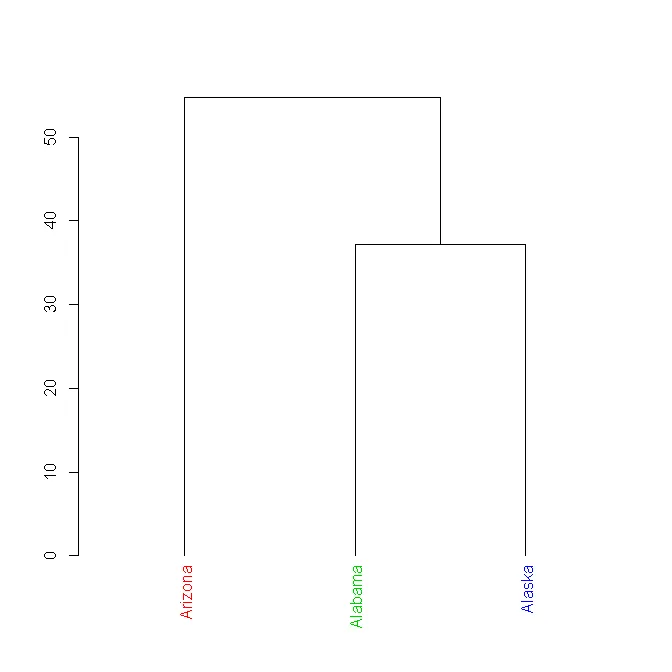我想修改从hclust对象绘制的树状图中叶子的属性。最少,我想要改变颜色,但是任何你能提供的帮助都会被赞赏。
我尝试过谷歌答案,但是我看到的每个解决方案似乎比我想象的要困难得多。
我想修改从hclust对象绘制的树状图中叶子的属性。最少,我想要改变颜色,但是任何你能提供的帮助都会被赞赏。
我尝试过谷歌答案,但是我看到的每个解决方案似乎比我想象的要困难得多。
clusDendro <- as.dendrogram(Clustering)
labelColors <- c("red", "blue", "darkgreen", "darkgrey", "purple")
## function to get colorlabels
colLab <- function(n) {
if(is.leaf(n)) {
a <- attributes(n)
# clusMember - a vector designating leaf grouping
# labelColors - a vector of colors for the above grouping
labCol <- labelColors[clusMember[which(names(clusMember) == a$label)]]
attr(n, "nodePar") <- c(a$nodePar, lab.col = labCol)
}
n
}
## Graph
clusDendro <- dendrapply(clusDendro, colLab)
op <- par(mar = par("mar") + c(0,0,0,2))
plot(clusDendro,
main = "Major title",
horiz = T, type = "triangle", center = T)
par(op)
# define dendrogram object to play with:
dend <- as.dendrogram(hclust(dist(USArrests[1:3,]), "ave"))
# loading the package
install.packages('dendextend') # it is now on CRAN
library(dendextend)# let's add some color:
labels_colors(dend) <- 2:4
labels_colors(dend)
plot(dend)

不清楚你想用它做什么,但我经常需要在树状图中识别一个分支。我已经修改了rect.hclust方法,添加了密度和标签输入。
You would call it like this:
k <- 3 # number of branches to identify
labels.to.identify <- c('1','2','3')
required.density <- 10 # the density of shading lines, in lines per inch <br>
rect.hclust.nice(tree, k, labels=labels.to.identify, density=density.required)这是函数
rect.hclust.nice = function (tree, k = NULL, which = NULL, x = NULL, h = NULL, border = 2,
cluster = NULL, density = NULL,labels = NULL, ...)
{
if (length(h) > 1 | length(k) > 1)
stop("'k' and 'h' must be a scalar")
if (!is.null(h)) {
if (!is.null(k))
stop("specify exactly one of 'k' and 'h'")
k <- min(which(rev(tree$height) < h))
k <- max(k, 2)
}
else if (is.null(k))
stop("specify exactly one of 'k' and 'h'")
if (k < 2 | k > length(tree$height))
stop(gettextf("k must be between 2 and %d", length(tree$height)),
domain = NA)
if (is.null(cluster))
cluster <- cutree(tree, k = k)
clustab <- table(cluster)[unique(cluster[tree$order])]
m <- c(0, cumsum(clustab))
if (!is.null(x)) {
if (!is.null(which))
stop("specify exactly one of 'which' and 'x'")
which <- x
for (n in 1L:length(x)) which[n] <- max(which(m < x[n]))
}
else if (is.null(which))
which <- 1L:k
if (any(which > k))
stop(gettextf("all elements of 'which' must be between 1 and %d",
k), domain = NA)
border <- rep(border, length.out = length(which))
labels <- rep(labels, length.out = length(which))
retval <- list()
for (n in 1L:length(which)) {
rect(m[which[n]] + 0.66, par("usr")[3L], m[which[n] +
1] + 0.33, mean(rev(tree$height)[(k - 1):k]), border = border[n], col = border[n], density = density, ...)
text((m[which[n]] + m[which[n] + 1]+1)/2, grconvertY(grconvertY(par("usr")[3L],"user","ndc")+0.02,"ndc","user"),labels[n])
retval[[n]] <- which(cluster == as.integer(names(clustab)[which[n]]))
}
invisible(retval)
}